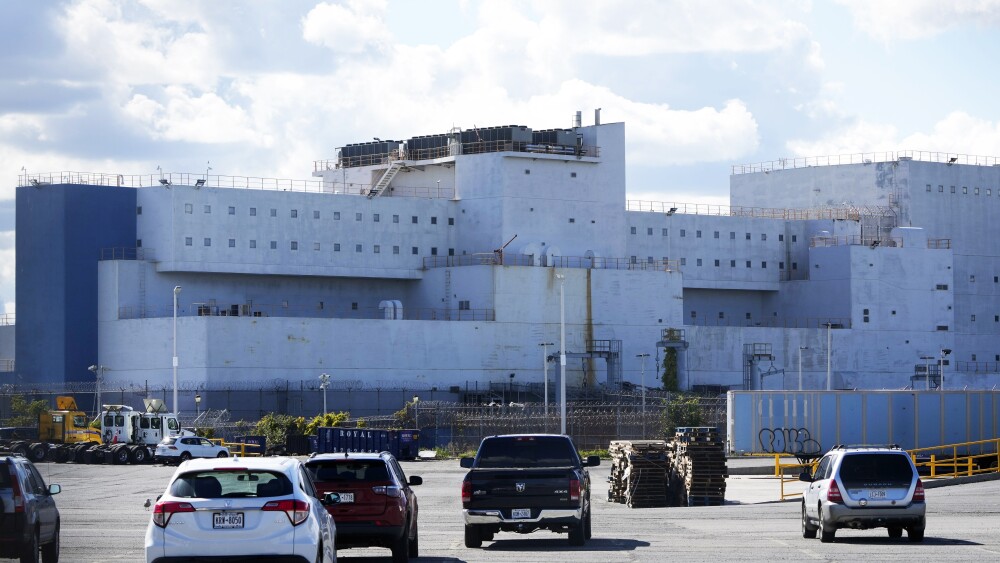By Jake Offenhartz
Associated Press
NEW YORK — Docked in the shallows off an industrial edge of the South Bronx, the Vernon C. Bain Correctional Center is a five-story jail barge that stretches the length of two football fields, resembling a container ship stacked with cargo.
It arrived in 1992 as a temporary measure to ease overcrowding on Rikers Island, the city’s main jail complex for detainees awaiting trial. Three decades later, the 800-bed lockup – the last operating prison ship in the United States — is finally closing down.
The ship will be fully vacated by the end of this week, officials said, as part of a broader plan to replace the city’s long-troubled correctional system with a network of smaller jails. For now, most of the roughly 500 people incarcerated on the ship will be transferred to Rikers Island, according to the Department of Correction, though the jails there are eventually supposed to close down, too.
Detainees and advocates have long regarded the boat as a grim vestige of mass incarceration, an enduring symbol of the city’s failures to reform dangerous jails that exist on the periphery of New York, largely out of sight of most residents and tourists.
The last of an armada of floating jails used by New York City in the late 1980s and early 1990s, the Vernon C. Bain sits across the river from Rikers Island, between a wastewater treatment plant and a wholesale fish market.
Detainees are afforded a daily hour of recreation on a caged upper deck, where they were recently seen playing basketball on a sunny morning. Otherwise, their only natural light beams through the ship’s tiny portholes.
Those who’ve spent time on board say the boat rocks in the river’s current. Its fading blue and white exterior — a far cry from the freshly-painted surfaces visible in the 1993 film “Carlito’s Way” — is known to leak in the rain, occasionally short-circuiting the electrical system.
Inside, rust cracks off the walls and detainees say they are packed into dormitories that grow suffocatingly hot in the summer, with cots that sit just a few inches from each other.
The use of maritime jails in the United States has long been controversial, dating back to the earliest days of the Revolutionary War, when thousands of Americans died aboard British ships parked in the New York Harbor.
Since then, the concept has been put to use sparingly — during the gold rush in California, most notably — often drawing allegations of cruelty and neglect, according to a recent study.
In the 1960s, a proposal by New York’s correction commissioner to house inmates on repurposed ships was sunk by other local officials, who said the boats would give visitors the wrong image of the city. That sentiment began to change in the late 1980s and early 1990s, as drug arrests during the crack epidemic brought the population of Rikers Island to historic highs.
By the time the Vernon C. Bain boat arrived in the South Bronx, the city had already deployed four other floating jails — including two converted city ferries and a former trooper ship with the dissonant nickname, the “Love Boat” — as low-cost, temporary facilities.
Mayor Edward Koch, an early champion of the idea, assured reporters that seasick inmates would be given Dramamine and dismissed questions about the boats’ viability, describing them as “better accommodations” than Rikers Island.
When the boat empties out, it won’t be the first time. It also closed in the mid-1990s, as the population of Rikers Island began to fall. But unlike the other shuttered floating jails, the Vernon C. Bain reopened — initially as a juvenile justice center under Mayor Rudy Giuliani, and later transitioning into a standard adult jail.
A spokesperson for the Department of Correction, Latima Johnson, declined to say what the city plans to do with the boat going forward. It will remain, for now, within the custody of the Department of Correction.
“The reason for this move is to centralize operations on the island to more efficiently manage people in custody and deploy staff and resources,” Johnson said in an email.












